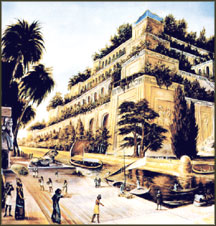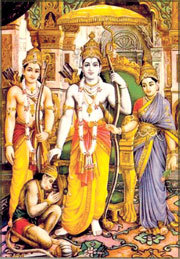|
DAILY NEWS ONLINE |
|
|
|
OTHER EDITIONS |
|
|
|
|
|
|
|
|
|
OTHER LINKS |
|
|
|
|
|
|
  |
|
All for the love of a woman
|
|
|
The Trojan war erupted when Helen of Greece eloped with Paris to Troy, deserting her husband, Meneleus. She was the most beautiful woman in the world at the time of the Trojan war, her face launched a thousand ships.
In ancient Sri Lanka, Rama of India arrived in the island and waged war against Ravana the demon king of Sri Lanka, who had abducted Rama's beautiful wife, Sita. In ancient India, Emperor Sha Jahan built the magnificent Taj Mahal to perpetuate his love for his queen Mumtaz Mahal.
|
|
In ancient Babylon, Nebuchadenzzar II built the Hanging Gardens (one of the Seven Wonders of the ancient world) to please his queen, Amyitis. Described below are two ancient monuments built for love.
Taj Mahal
Taj Mahal was built in Agra, India between 1631 and 1648 by a Muslim, Emperor Shah Jahan (died 1666) in the memory of his dear wife and Queen Mumtaz Mahal. It is an "elegy in marble" or some say an expression of a "dream".
Taj Mahal, the jewel of Muslim art in India, is considered to be the 8th Wonder of the World, and listed by UNESCO as one of the 628 cultural heritage sites in the world, worthy of preserving for their universal value.
|
|
Western historians have noted that the architectural beauty of Taj Mahal has never been surpassed. The famous monument, built entirely of marble, is the most beautiful monument built by the Mughals, the Muslim rulers of India.
Taj Mahal (meaning Crown Palace) is a Mausoleum that houses the grave of Queen Mumtaz Mahal at the lower chamber. The grave of Sha Jahan who ascended the throne in 1628, was added to the mausoleum later.
Taj Mahal was constructed, employing twenty thousand workers. It was completed in 1648 at a cost of 32 million Indian Rupees. The construction documents show that its master architect was Ustad 'Isa, the renowned Islamic architect of his time.
|
|
The Taj stands on a raised, square platform (186 x 186 feet) with its four corners truncated, forming an unequal octagon.
The architectural design uses the interlocking arabesque concept, in which each element stands on its own and perfectly integrates with the main structure. It uses the principles of self-replicating geometry and a symmetry of architectural elements.
Its central dome is fifty-eight feet in diameter and rises to a height of 213 feet. The mausoleum is a part of a vast complex comprising a main gateway, an elaborate garden, a mosque (to the left), a guest house (to the right) and other palatial buildings.
The story of Taj Mahal began in 1607, when the 15-year-old Prince Khurram, who was the eldest son of Emperor Jahangir, saw an exquisitely pretty girl named Arjumand Banu sitting with her silks and glass heads at her shop in the Meena Bazzar, close to his father's harem.
She was the daughter of Asaf Khan, the brother of the Emperor Jahangir's consort, Noorjahan. Khurram was drawn to her. He saw a piece of glass at her stall and asked its worth.
When she replied that it was diamond and not glass, he gave her ten thousand rupees (a sum she boldly said he could not afford), picked up the piece of glass and left carrying with him her image in his mind. Love blossomed between the two and finally marriage took place between them in 1612. Khurram was then 20 years and Arjumand 19 years of age.
She loved Khurram so much so that she was literally inseparable from Khurram at any given moment; she often accompanied him with an entourage when he went to fight wars. In her 19 years of marriage, she bore him 14 children, seven of whom did not live to reach maturity.
She daily rose in his confidence; eventually winning the royal seal, Muhr Uzah. She continually interceded on behalf of petitioners and gave allowances to widows and orphans.
Like many royal ladies, she also had nerves of steel. She is said to have enjoyed the spectacle of men in combat with animals. Shah Jhan is believed to have persecuted the Portuguese at Hooghly at her behest.
Mumtaz Mahal died in childbirth in 1630. As she lay on her deathbed, it is said that she whispered to him to build for her a monument that would symbolize the beauty of their love.
For a week Shah Jahan remained behind closed doors. When he emerged his hair had turned white, his back was bent, his face worn with despair. The entire kingdom was ordered into mourning for two years.
When Taj Mahal was nearing completion, Shah Jahan was taken prisoner by his own son who usurped power from Jahan. It is on record that for fifteen years until his death, he watched his Taj Mahal coming up, through a window of his prison far away.
The Hanging Gardens of Babylon
Love for a woman prompted Nebuchadnezzar II of Babylonia to order the Hanging Gardens of Babylon to be built during his reign of 43 years (604-562 BC). The Babylonian kingdom flourished under the rule of the famous King, Hammurabi (1792-1750 BC).
It was not until the reign of Naboplashar (625-605 BC) of the Neo-Babylonian dynasty that the Mesopotamian civilization reached its ultimate glory. His son. Nebuchadnezzar II (604-562 BC), is credited for building the legendary Hanging Gardens to please his homesick wife of concubine, Amyitis, who was from Media.
She longed for the meadows and mountains of her homeland. He married her to make an alliance between Media and Babylonia. She was raised in a green and mountainous land. Amyitis found Mesopotamia depressing, as it is a flat and sun-baked environment.
Nebuchadnezzar, with hope of making her happier, decided to build a "recreated homeland" which was an artificial mountain with rooftop gardens. The gardens were made to look like a natural Median wilderness. The gardens had exotic flourishing plants.
These plant were cultivated above ground level. Nebuchadnezzar imported the plants from foreign lands. The gardens formed a quadrilateral shape. There were stairways that led to the uppermost terraced roofs. The entire structure measured 400 feet by 400 feet.
Although they no longer exist, the idea of such a magnificent feat of engineering still fascinates people today. Philo highlighted the various qualities that made the gardens worthy of incorporation onto the list of Seven Wonders of the World in the 3rd century B.C.
It was a terraced garden that exhibited many beautiful plants and held many fountains. Nebuchadnezzar built the Hanging Gardens, breaking natural law by creating a botanical wonder, an "impulse deriving from the love of a woman".
The gardens were as much of a technological feat as they were an architectural triumph. The technique of hydro-engineering demonstrated their knowledge of irrigation. Since Babylon rarely received rain, the gardens had to be irrigated.
Streams of water emerged from elevated sources and flowed down the inclined channels. This kept the whole area moist and thus the grass was always green. The source of the gardens' water was from the Euphrated River.
Ultimately, the Hanging Gardens of Babylon lasted through the time of Alexander the Great. Detailed descriptions of the Gardens come from ancient Greek sources, including the writings of Strabo, Berossus and Diodorus Siculus, and Philo of Byzantium.
Babylonian records stay silent on the matter. Tablets from the time of Nebuchadnezzar do not have a single reference to the Hanging Gardens, although descriptions of his palace, the city of Babylon, and the walls are found.
(The article is written by the author/publisher of two new books launched recently. They are: "Rituals, Folk Beliefs and Magical Arts of Sri Lanka, the New Version and "Alien Mysteries in Sri Lanka and Egypt, the New Version". They are available at leading bookshops)
|
|





